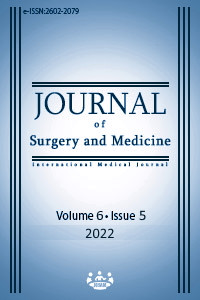Do myometrial lesions affect the discrepancy of pathological findings in women with endometrial hyperplasia?
Keywords:
Adenomyosis, Endometrial hyperplasia, Leiomyoma, DiagnosisAbstract
Background/Aim: Benign myometrial lesions are frequently found in pathologic specimens of hysterectomies. High rates of coexistence of these lesions with endometrial cancer have also been reported. Our aim was to evaluate the effect of myometrial lesions on the consistency of diagnoses between endometrial sampling results and final hysterectomy findings in patients with endometrial hyperplasia (EH) before hysterectomy. Methods: Two hundred seventeen patients who were diagnosed as having EH via endometrial sampling and underwent hysterectomy within three months were included in this retrospective cohort study. The patients’ preoperative and postoperative pathologic findings were compared, and discordant results were defined to be either overdiagnosed or underdiagnosed. Results: The overall diagnostic concordance between the endometrial sampling results and the final hysterectomy pathologic findings was 32.2%. The rate of concurrent endometrial carcinoma (EC) among all EH was 22.1%. The discordance between preoperative endometrial sampling and final hysterectomy specimen results was evaluated, and patients with underdiagnosis were older (60.5 years, P < 0.001), had a higher BMI (30.84 kg/m2, P < 0.001), were mostly postmenopausal (P < 0.001), had lower parity numbers (median = 2, P = 0.002), and had a lower rate of co-existing adenomyosis (P = 0.009). The rates of co-existing leiomyoma between the groups were not different. No effect of other demographic characteristics was observed in the multivariate regression analysis; however, the presence of adenomyosis was a significant independent risk factor affecting a 5.8-fold increase in overdiagnosis (-1.50; OR: 0.17 (0.05-0.50) P = 0.002) and 4.5-fold increase in underdiagnosis (-1.50; P = 0.005). Conclusion: Co-existing adenomyosis could lead to discordance of the pathologic findings in women with EH diagnoses before hysterectomy.
Downloads
References
Kadirogullari P, Atalay CR, Ozdemir O, Sari ME. Prevalence of co-existing endometrial carcinoma in patients with preoperative diagnosis of endometrial hyperplasia. J Clin Diagn Res. 2015;9(10):Qc10–4.
Sccully RE, Bonfiglio TA, Kurman RJ. Histological typing of female genital tumors: international histological classification of tumors. 2nd ed. Springer-Verlag, New York 1994. p.13.
Sobczuk K, Sobczuk A. New classification system of endometrial hyperplasia WHO 2014 and its clinical implications. Menopause Rev. 2017;16(3):107–11.
Rakha E, Wong SC, Soomro I, Chaudry Z, Sharma A, Deen S, et al. Clinical outcome of atypical endometrial hyperplasia diagnosed on an endometrial biopsy: Institutional experience and review of literature. Am J Surg Pathol. 2012;36:1683–90.
Trimble CL, Kauderer J, Zaino R, Silverberg S, Lim PC, Burke JJ. Concurrent endometrial carcinoma in women with a biopsy diagnosis of atypical endometrial hyperplasia: A Gynecologic Oncology Group study. Cancer. 2006;106:812–9.
Kurman RJ, Norris HJ. Evaluation of criteria for distinguishing atypical endometrial hyperplasia from well-differentiated carcinoma. Cancer. 1982;49:2547-59.
Giannella L, Delli Carpini G, Sopracordevole F, Papiccio M, Serri M, Giorda G, et al. Atypical Endometrial Hyperplasia and Unexpected Cancers at Final Histology: A Study on Endometrial Sampling Methods and Risk Factors. Diagnostics (Basel). 2020;13:10(7):474.
Hwang WY, Suh DH, Kim K, No JH, Kim YB. Aspiration biopsy versus dilatation and curettage for endometrial hyperplasia prior to hysterectomy. Diagn Pathol. 2021;14;16(1):7.
Erdem B, Aşıcıoğlu O, Seyhan NA, Peker N, Ülker V, Akbayır Ö. Can concurrent high-risk endometrial carcinoma occur with atypical endometrial hyperplasia? Int J Surg. 2018;53:350-3.
Garcia, L. Isaacson K. Adenomyosis: review of the literature. J Minim Invasive Gynecol. 2011;18:428–37.
Pavone D, Clemenza S, Sorbi F, Fambrini M, Petraglia F. Epidemiology and Risk Factors of Uterine Fibroids. Best Pract Res Clin Obstet Gynaecol. 2018;46:3-11.
Mao X, Zheng W, Mao W. Malignant changes in adenomyosis in patients with endometrial adenocarcinoma: A case series. Medicine 2017;.96(43):e8336.
Raffone A, Seracchioli R, Raimondo D, Maletta M, Travaglino A, Raimondo I, et al. Prevalence of adenomyosis in endometrial cancer patients: a systematic review and meta-analysis. Arch Gynecol Obstet. 2021;303(1):47-53.
Johnatty SE, Stewart CJR, Smith D, Nguyen A, O' Dwyer J, O'Mara TA, et al. Co-existence of leiomyomas, adenomyosis and endometriosis in women with endometrial cancer. Sci Rep. 2020;27;10(1):3621.
Pecorelli S. Revised FIGO staging for carcinoma of the vulva, cervix, and endometrium. Int J Gynaecol Obstet. 2009;105(2):103-4.
Bird CC, Mc Elin T, Wand Manalo‑Estrella P. The elusive adenomyosis of the uterus‑revisited. Am J Obstet Gynecol. 1972;112:583-93.
Andres MP, Borrelli GM, Ribeiro J, Baracat EC, Abrão MS, Kho RM. Transvaginal Ultrasound for the Diagnosis of Adenomyosis: Systematic Review and Meta-Analysis. J Minim Invasive Gynecol. 2018;25(2):257-64.
Aleksandrovych V, Basta P, Gil K. Current facts constituting an understanding of the nature of adenomyosis. Adv Clin Exp Med. 2019;28(6):839-46.
Vetter MH, Smith B, Benedict J, Hade EM, Bixel K, Copeland LJ, et al. Preoperative predictors of endometrial cancer at time of hysterectomy for endometrial intraepithelial neoplasia or complex atypical hyperplasia. Am J Obstet Gynecol. 2020; 222(1):60.e1-60.e7.
Hui LS, Chin SHM, Goh C, Hui LX, Mathur M, Kuei TLY, et al. Non-atypical endometrial hyperplasia: risk factors for occult endometrial atypia and malignancy in patients managed with hysterectomy. Obstet Gynecol Sci. 2021;64(3):300-8.
Lee N, Lee KB, Kim K, Hong JH, Yim GW, Seong SJ, et al. Risk of occult atypical hyperplasia or cancer in women with nonatypical endometrial hyperplasia. J Obstet Gynaecol Res. 2020;17.
Abdelazim IA, Aboelezz A, Abdulkareem AF. Pipelle endometrial sampling versus conventional dilatation & curettage in patients with abnormal uterine bleeding. J Turkish German Gynecol Assoc. 2013;14(1):1–5.
Kimura T, Kamiura S, Komoto T, Seino H, Tenma K, Ohta Y, Clinical over- and under-estimation in patients who underwent hysterectomy for atypical endometrial hyperplasia diagnosed by endometrial biopsy: the predictive value of clinical parameters and diagnostic imaging. Eur J Obstet Gynecol Reprod Biol. 2003;10;108(2):213-6.
Downloads
- 446 459
Published
Issue
Section
How to Cite
License
Copyright (c) 2022 Fatma Nurgül Taşgöz, Nergis Kender
This work is licensed under a Creative Commons Attribution-NonCommercial-NoDerivatives 4.0 International License.
















